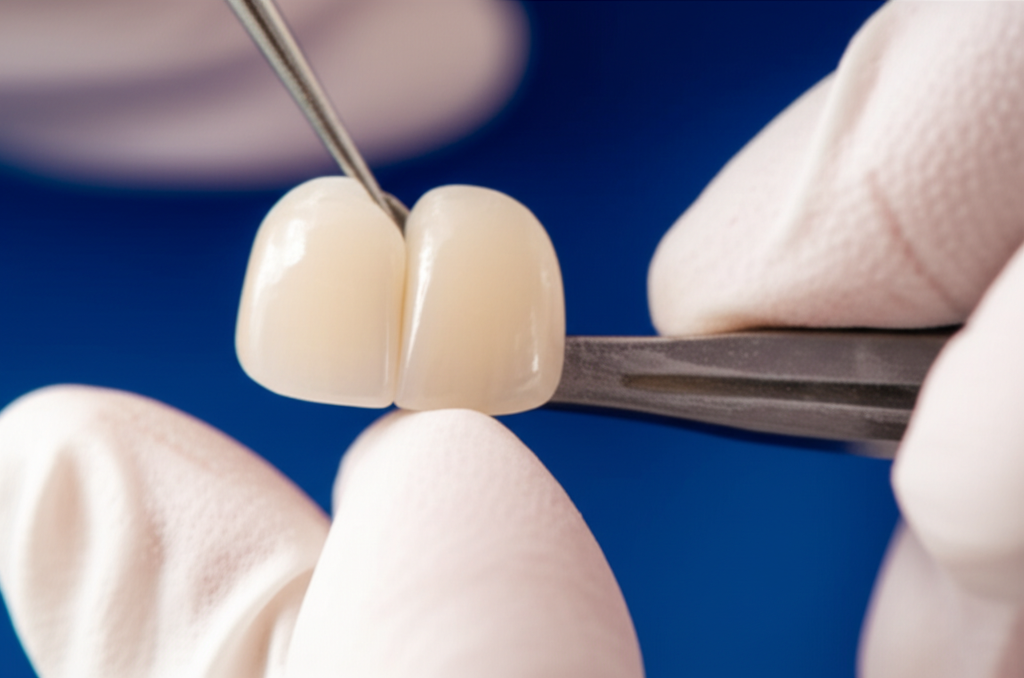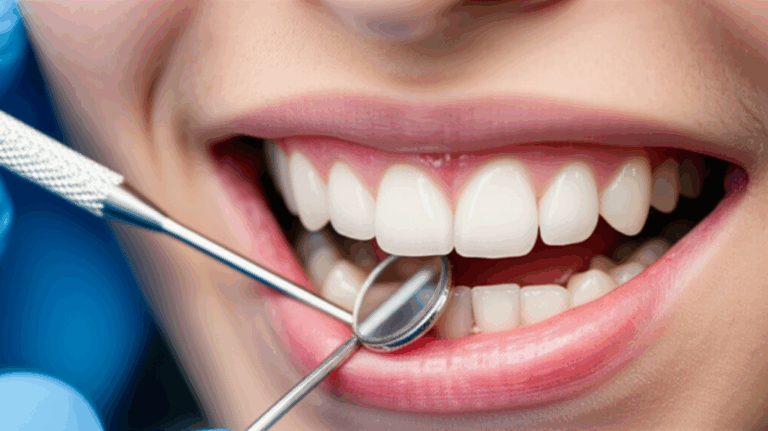
Can Porcelain Veneers Be Reshaped? Understanding Your Options for Adjustment and Repair
That annoying feeling when something just doesn’t feel right about your smile—you’ve invested in porcelain veneers, but every time you look in the mirror or bite into your lunch, you notice they’re a bit too long, a little sharp, or maybe there’s a rough edge that bugs you. You might be thinking, “Can these expensive veneers actually be changed, or am I stuck with them the way they are?”
You’re not the only one who wonders this. Many people have the same worries—about how they look, how their teeth feel, or about a chip they didn’t expect. Knowing what can and can’t be done gives you more confidence about your teeth—and some peace of mind.
In This Article:
- The Truth About Reshaping Porcelain Veneers
- Porcelain Veneers: Strong but Not Easy to Change
- When Reshaping IS Possible: Small Adjustments & Touch-ups
- Limits and Risks of Reshaping Porcelain Veneers
- What the Dentist Does to Fix Veneers
- Cost of Reshaping vs. Getting New Veneers
- What If Reshaping Won’t Work? (Other Choices)
- Porcelain vs. Composite Veneers: What’s the Difference?
- Taking Care of Your Reshaped Veneers
- When to See a Dentist About Veneers
- Conclusion: You’re in Charge of Your Smile
- Frequently Asked Questions
The Truth About Reshaping Porcelain Veneers
Let’s get right to it. Can a dentist change porcelain veneers after they’re glued on your teeth?
Yes—but only a little, and there are things you need to know first.
Dentists can make small changes to porcelain veneers after they’re stuck on your teeth. If a veneer is too long, has a sharp or rough edge, or makes your bite uncomfortable, your dentist can smooth or adjust the veneer to fit better and feel more comfortable.
But here’s the thing: porcelain, unlike your own tooth or composite (white plastic resin) veneers, can’t be fixed or rebuilt if too much is taken away. Every time your dentist makes a change, a bit of the thin ceramic cover is lost. If they remove too much, the veneer—or even your own tooth—could get damaged.
Common reasons people want their veneers fixed:
- Veneers look too long, wide, or stick out too much.
- There’s a sharp or rough edge bothering their lips or tongue.
- There’s a chip or crack that looks bad.
- Their bite feels weird when eating or talking.
Of course, everyone’s teeth and smile are different. Let’s look at how veneers work, what repairs are possible, and what to do next if you’re not happy.
Porcelain Veneers: Strong but Not Easy to Change
Ever wonder what makes porcelain veneers look great and last a long time?
Think of porcelain veneers as really thin, carefully made “covers” made out of special ceramic. Dentists glue them to the front of your teeth with a strong dental glue. Unlike resin (the stuff used in bonding), porcelain is cooked at really high heat, so it’s very hard and doesn’t stain easily.
Porcelain veneers facts:
- Material: Strong ceramic (like feldspathic porcelain, Emax, or zirconia)
- Bond: The glue and how it’s put on make it stick really well to your tooth.
- Surface: The shiny, glassy layer gives them a dental shine and protects from stains.
- Thickness: Usually 0.3mm to 1mm—about as thin as a contact lens.
- Change Limit: You can’t put the porcelain back if it’s taken away, and it can break if you press or grind too much.
Simple example:
Your veneer is like a nice ceramic mug. You could sand a rough spot or smooth a chip, but do it too much and you might break through! And if you sand off the glaze, coffee and tea stains will show up fast.
So, porcelain is great for smiles, but it’s not easy to change after it’s put in.
When Reshaping IS Possible: Small Adjustments & Touch-ups
Smoothing Edges and Shortening
If your veneer feels too sharp or long, your dentist can carefully trim or smooth out the edge using special tools. Sometimes, just taking off a tiny bit (half to one millimeter) makes your smile feel and look better.
For example:
Say Ms. A gets her top veneers and notices her front teeth are a tad long. Her dentist shortens them by about 0.5 mm and polishes the edge. Suddenly, her smile looks and feels just right.
Repairing Small Chips and Rough Spots
If you get a little chip on the edge of a veneer from biting something hard, the dentist can smooth the area so it feels good again—if the chip is small and your tooth isn’t showing.
Fixing Bite Problems
If your bite feels different after veneers, a tiny adjustment to high spots (places where teeth touch too hard) can really help. Your dentist uses colored paper to see where teeth hit, then lightly files away the problem areas.
Reducing Thickness
Sometimes veneers feel too thick, especially by the gums or at the edges. Small reductions can help, but remember: each veneer is already very thin, so only small amounts should be taken away.
Reminder:
All these fixes are “small.” Don’t expect a square-looking tooth to become pointy, or to make big changes in color. For those, you’ll need a new veneer.
Limits and Risks of Reshaping Porcelain Veneers
Small changes are possible. But let’s talk about what can go wrong:
1. It’s Forever—No Way to Undo
Once you take porcelain away, it’s gone for good. If you change your mind, you’ll probably need a whole new veneer.
2. Losing the Shine
That glassy, shiny top layer that keeps veneers looking nice and stops stains can’t be redone easily at the dentist.
- Filing or grinding takes off the factory shine.
- Dentists can smooth it out, but it’s not as shiny.
- Studies show reshaped spots get stained 10–20% easier than shiny, untouched spots.
So in time, those edges can turn yellow or darker—especially if you drink coffee, smoke, or don’t brush well.
3. Weaker Veneers
Veneers are only strong if they’re thick enough.
- Take away too much and the veneer can crack or pop off.
- Grinding too much could expose your own tooth under the veneer and cause sensitivity.
- Extra-thin veneers might break or come off when you chew.
4. Not as Good-Looking
It’s hard to make reshaped parts look exactly as smooth and shiny as before.
- The spot may look duller or rougher under bright light or in photos.
5. Tooth Sensitivity
Go too far on the edge, and you might feel nerve twinges from hot, cold, or sweet snacks—because your real tooth may be a bit exposed.
6. Big Changes Need a New Veneer
If you want to change your tooth’s shape, color, or size a lot, you’re better off with a new veneer. Trying to reshape the old one too much causes more trouble than it solves.
What the Dentist Does to Fix Veneers
Ready for a touch-up? Here’s what usually happens:
1. First Visit
Your dentist will listen to what’s bugging you, check your veneers (sometimes with x-rays), and see if your bite is right.
2. Talk About Risks and Benefits
Because every fix is permanent, your dentist will explain what can be done and what the result might look and feel like.
3. Numbing (If Needed)
Fixing veneers doesn’t usually hurt, but if the spot is near your gums or you’re sensitive, you might get some numbing.
4. Gentle Grinding and Smoothing
Tiny diamond or ceramic tools take just a bit off here and there.
- For small changes, this takes only a few minutes.
- Dentist will then use fine sanding and polishing to smooth the spot as much as possible.
5. Checking Your Bite
You’ll be asked to bite on colored paper to find any high spots, which get a final polish.
6. Care Afterwards
It may feel odd at first, but your mouth adjusts.
- You’ll get cleaning advice and a reminder to be careful eating hard foods for a few days.
- Watch out for new sensitivity or color changes—call your dentist if you notice anything.
Cost of Reshaping vs. Getting New Veneers
Talking about money always matters.
Small Veneer Fixes:
- $50 to $300 per veneer in the U.S.
- Usually done in one dentist visit, no outside lab needed.
Getting a New Veneer:
- $800 to $2,500 per veneer
- Requires new molds, lab work, and another visit.
In short:
If a small fix is possible, it’s much cheaper and simpler than starting over. But remember, sometimes a new veneer is truly the best solution. When you’re unsure, it’s smart to ask your dentist or get a second opinion.
What If Reshaping Won’t Work? (Other Choices)
Not every fix is simple—but you still have choices.
1. Veneer Replacement
If the change you need is big (or fixing would make the veneer too thin), a new veneer is safest. This way you get the best shape, look, and comfort, with less risk of cracking or pain. Great veneer labs often work with dentists to make custom solutions.
2. Dental Bonding
For tiny chips or to make a small area look better, dental bonding (tooth-colored resin) might help. Just know: resin sticks better to your real tooth than to porcelain, so the fix may not last forever. It’s good for short-term fixes.
3. Dental Crowns
If the veneer and the tooth under it are damaged, your best bet may be a crown. Crowns cover your whole tooth, and they’re really reliable—good for back teeth or weak teeth.
4. Accepting Small Flaws
No smile is perfect, and sometimes a small chip or rough spot doesn’t hurt or cause problems. Your dentist might suggest leaving it unless it gets worse or starts to bother you more.
Tip: For changes that are mostly about looks, ask for a trial or computer preview before making changes.
Porcelain vs. Composite Veneers: What’s the Difference?
Not all veneers can be changed the same way. Here’s why porcelain veneers are tricky.
Porcelain Veneers:
- Very hard and don’t stain easy
- Really thin (so don’t allow for big changes)
- The shiny glaze can’t be redone in the office
- After they’re on, you can only do small touch-ups
Composite (Resin) Veneers:
- Made from a softer white plastic
- Easy to file, smooth, add to, or reshape at the dentist
- Not as shiny and “real-looking” as porcelain
- Stain more with time, but simple to repair
Example:
Porcelain veneers are like bathroom tile—hard, tough, but not bendable. Composite is like modeling putty—easy to change, but easier to mark up or wear down.
Simple point:
Go with porcelain for beauty and strength, but don’t expect to make big fixes after it’s glued on.
Taking Care of Your Reshaped Veneers
Whether you just got veneers, or just had yours changed, what you do daily matters.
Easy Veneer Care Tips:
- Brush twice a day with gentle toothpaste and a soft brush. This stops stains—especially if the edge isn’t as shiny as before.
- Floss every day to clean between teeth and near the gums.
- Use mouthwash to help stop plaque and gum problems.
- Don’t chew hard stuff like ice or hard candy that can break porcelain.
- Wear a night guard in bed if you grind your teeth.
See your dentist for regular checks and cleanings—they have special tools and paste for polishing areas that get stains.
Want more on great veneer care? Check out our dental practical guide.
When to See a Dentist About Veneers
Not sure if you need a fix or even a new veneer? Go to the dentist if you notice:
- Ongoing pain or sensitivity weeks after getting your veneers
- A veneer that feels too “high” or makes your bite feel off
- A sharp, rough, or chipped edge
- Stains showing up on the edge or by your gums
- Any cracking or if the veneer feels loose
- Trouble flossing or red, swollen gums
- You just aren’t happy with how they look, but don’t know what to do
Tip:
See a dentist who knows cosmetic dentistry well. Some general dentists don’t have the skill or the right lab partners. Ask if your dentist works with an expert china dental lab for best results.
Conclusion: You’re in Charge of Your Smile
Here’s what to remember:
- Porcelain veneers CAN be fixed—but only for little tweaks like edge smoothing or making them a tad shorter.
- Reshaping is permanent—you can’t take it back.
- Changing the veneer’s shape may remove its stain-resistant shine.
- Want a whole new look? That usually needs a new veneer.
- Careful small fixes don’t usually make a veneer last less time.
- See your dentist fast if you’re worried about your veneers—the sooner, the better.
You deserve teeth that look great and feel good. Don’t be shy—ask your dentist anything. The more you know, the easier it is to keep your smile just how you want it.
Frequently Asked Questions About Porcelain Veneer Reshaping
Q1: Can a dentist make my veneers shorter?
A1: Yes, most dentists can trim your porcelain veneers by up to 1mm. It’s usually quick and doesn’t hurt, but you may lose a bit of the original shine at the edge. Too much trimming could make the veneer weak or your tooth sensitive.
Q2: How much does it cost to fix a chipped porcelain veneer?
A2: Small fixes like smoothing a chip cost about $50–$300 each. If it’s a big chip or comes loose, a new veneer costs $800–$2,500.
Q3: Will reshaping my veneers make them weaker?
A3: If only a little is taken off, your veneers should stay strong. Taking too much away makes them easier to crack or fall off.
Q4: Can veneers be whitened after placement?
A4: No, porcelain veneers don’t get whiter with whitening products. You can whiten your regular teeth, but check with your dentist first.
Q5: What’s the lifespan of a reshaped veneer?
A5: If changes are small and polished well, they last as long as usual—about 10–15 years. Big fixes can shorten their life.
Q6: Can veneers feel thick or bulky after placement?
A6: Yes, sometimes they do, especially if the tooth under wasn’t reduced enough. Dentists can trim the veneer to make it feel more natural.
Your smile is worth protecting. Don’t wait—if something feels wrong with your veneers, speak up. You have choices, and you should love your look!
Find more hands-on info about teeth and care at our patient dental resource page.
Medically checked by a licensed dentist for accuracy.
Ready to see what you can do or need a good cosmetic dentist? Book a visit and let your smile match how you feel inside.








